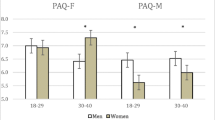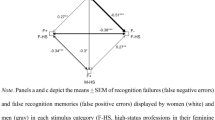Abstract
The relation between adults' gender-related personality characteristics and memory for gender-stereotyped and counterstereotyped televised information was examined. Eighty middle-class undergraduates, equally divided by gender (92% Caucasian and 8% minority groups), viewed a television program that presented two plots: one was traditionally gender-stereotyped and the other was counterstereotyped. Three weeks after viewing, students answered questions assessing their recall of stereotyped and counterstereotyped information that had been presented in the television program. Masculinity and femininity scores were also assessed. Results indicated that gender aschematic adults recalled more counterstereotypical information than did gender schematic adults. Results were interpreted within an information processing model.
Similar content being viewed by others
References
Alba, J. W., & Hasher, L. (1983). Is memory schematic? Psychology Bulletin, 93, 203–231.
Bem, S. L. (1974). The measurement of psychological androgyny. Journal of Consulting and Clinical Psychology, 42, 155–162.
Bem, S. L. (1976). Probing the promise of androgyny. In J. Sherman & F. Denmark (Eds.), Psychology of women: Future directions of research.
Bem, S. L. (1977). On the utility of alternative procedures for assessing psychological androgyny. Journal of Consulting and Clinical Psychology, 45, 196–205.
Bem, S. L. (1983). Gender schema theory and its implications for child development: Raising gender aschematic children in a gender schematic society. Signs: Journal of Women in Culture and Society, 8, 598–616.
Bem, S. L., & Lenney, E. (1976). Sex typing and the avoidance of cross-sex behavior. Journal of Personality and Social Psychology, 33, 48–54.
Calvert, S. L., & Huston, A. C. (1987). Television and children's gender schemata. New Directions for Child Development, 38, 75–88.
Comstock, G., with Paik, H. (1991). Television and the American child. San Diego: Academic Press.
Halverson, C. F., & Martin, C. L. (1983). The effects of sex-typing schemas on young children's memory. Child Development, 54, 563–574.
Huston, A. C. (1983). Sex-typing. In P. H. Mussen (Ed.), Handbook of child psychology, Volume 4. New York: John Wiley.
Lewittes, H. J., & Bem, S. L. (1983). Training women to be more assertive in mixed-sex task-oriented discussions. Sex Roles, 9, 581–596.
List, J. A., Collins, W. A., & Westby, S. D. (1983). Comprehension and inferences from traditional and nontraditional sex-role portrayals on television. Child Development, 54, 1579–1587.
Martin, C. L. (1990). Attitudes and expectations about children with nontraditional and traditional gender roles. Sex Roles, 22, 151–165.
Martin, C. L., & Halverson, C. F. (1981). A schematic processing model of sex-typing and stereotyping in children. Child Development, 52, 1119–1134.
Martin, C. L., Wood, C. H., & Little, J. K. (1990). The development of gender stereotypes. Child Development, 61, 1891–1904.
Spence, J. T., Helmreich, R. L., & Stapp, J. (1975). Ratings of self and peers on sex-role attributes and their relation to self-esteem and conceptions of masculinity and femininity. Journal of Personality and Social Psychology, 32, 29–39.
Taylor, S. E., & Crocker, J. (1981). Schematic bases of social information processing. In Social Cognition: The Ontario Symposium, Volume 1. Hillsdale, NJ: Lawrence Erlbaum Associates.
Vidmar, N., & Rokeach, M. (1974). Archie Bunker's bigotry: A study in selective perception and exposure. Journal of Communication, 24, 36–47.
Author information
Authors and Affiliations
Additional information
The authors thank the students of Georgetown University who participated in this research.
Rights and permissions
About this article
Cite this article
Renn, J.A., Calvert, S.L. The relation between gender schemas and adults' recall of stereotyped and counterstereotyped televised information. Sex Roles 28, 449–459 (1993). https://doi.org/10.1007/BF00289607
Issue Date:
DOI: https://doi.org/10.1007/BF00289607




